Sherman Coolidge
Sherman Coolidge (1862-January 24, 1932), an Episcopal Church priest and educator, helped found and lead the Society of American Indians (1911-1923). That first national American Indian rights organization run by and for Native Americans pioneered twentieth-century Pan-Indianism, the philosophy and movement promoting unity among American Indians regardless of tribal affiliation.

Coolidge spent twenty-six years preaching and teaching at Wind River Reservation at Fort Washakie, Wyoming, as well as traveled throughout United States lecturing on behalf of American Indians. In 1923, Coolidge served on President Calvin Coolidge's "Committee of One Hundred" to review and advise on American Indian policy. In the 1920s, Coolidge was transferred to Colorado where he served as Canon at the Cathedral of St. John in the Wilderness in Denver, Colorado, and in Colorado Springs, Colorado.
Early life
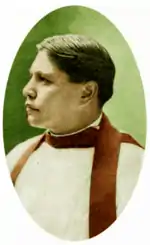
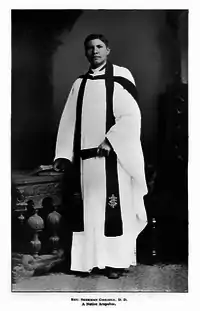
In 1862 near Goose Creek in the Wind River area of Wyoming, Banasda (Big Heart) and Ba-ahnoce (Turtle Woman), both Arapaho, gave their newborn son the name Runs-on-Top. They were related to Chief Washakie, head of the Eastern Shoshone, and for whom Washakie County and Fort Washakie, Wyoming were named. When Runs-on-Top was seven, his father was killed by a war party of Bannocks intent on stealing horses. The Bannocks and Arapahos at the time were adversaries, often at war with each other. Runs-on-Top and his younger brother, Little One-Who-Dies-and-Lives-Again, escaped with their mother by hiding under a tipi cover and brush. The following spring (1870), a large contingent of Shoshones and Bannocks attacked the Arapahos near the present site of Lander, Wyoming. Runs-on-Top and his brother were taken captive, but their mother escaped.
Eventually, American troops rescued the boys, and allowed their adoption by separate white families by year's end. Lt. Charles A. Coolidge (a career soldier with the 7th U.S. Infantry as discussed below) and his wife Sophie Wagner Lowrey Coolidge adopted Runs-on-Top. Coolidge, whom the post surgeon had renamed Runs-on-Top "William Tecumseh Sherman" in honor of the Union General, as his brother had been renamed after General Philip Sheridan.[1] The nickname "Sherman" Coolidge stuck.[2]
Education
Guided by his adoptive parents, Sherman Coolidge rapidly accommodated to his new placement, which included an emphasis on education and Euro-American customs. In 1876, while accompanying his adoptive father with the Montana Column during the Great Sioux War, the boy began to consider becoming a missionary among the western tribes. At the age of nine, Coolidge was baptized by Episcopal missionary bishop Horatio Southgate and enrolled at the Shattuck Military School in Faribault, Minnesota (1877–1880), where he was an exemplary student and consistently ranked in the upper quarter of his class. In 1880, Sherman enrolled in the Seabury Divinity School, a seminary of The Episcopal Church, located in Evanston, Illinois, where he graduated with a Bachelor of Divinity degree in 1884 and was ordained as a deacon of the Episcopal Church by Bishop Henry Benjamin Whipple. He later undertook post-graduate studies at Hobart College, Geneva, New York (1887–1890).
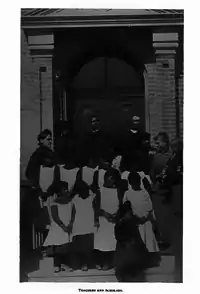
Ministry
The Bureau of Indian Affairs had assigned the Episcopal Church eight Indian agencies: seven in Dakota Territory, and the Wind River Indian Agency in Wyoming. In 1884, Deacon Coolidge began assisting to Episcopalian priest John Roberts at the St. Michael's Mission and government school at Ethete, Wyoming for the Shoshones.[3] On May 25, 1885, Bishop John Franklin Spalding of the Colorado Diocese ordained him a priest. Soon thereafter, Rev. Coolidge traveled to the Wind River Reservation in Wyoming for his first church assignment. At Wind River, Sherman was reunited with his birth mother, Ba-ahnoce, who had learned of his impending return and ultimately converted to Christianity.
During his early years at the reservation, Coolidge also served as a mediator between the Arapahos and Shoshones who shared opposite ends of the reservation. From 1887–1890, through kindness of President Eliphalet Potter, Rev. Coolidge left the reservation for post-graduate studies Hobart College, Geneva, New York.[4] Upon returning to the Wind River Agency, he continued to minister to Native and European-Americans alike for twenty-six years.[5]
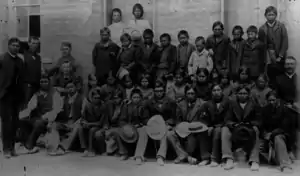
Marriage and family
After returning to the Wind River Agency, Sherman met Grace D. Wetherbee, the daughter of an affluent New York City couple, who was visiting a friend. Sharing an interest in the ministry, the couple married in October, 1902. Their marriage announcement appeared in the New York Times, headlined "Indian Husband Approved" continued: "Father of Miss Wetherbee who married Arapaho, gave full consent."
"Miss Grace D. Wetherbee, daughter of Gardner Wetherbee, one of the proprietors of the Hotel Manhattan, was married yesterday in Cheyenne to Bishop Sherman Coolidge, a full-blooded Arapahoe Indian, and a graduate of Hobart College. Miss Wetherbee met the Bishop some years ago while she was traveling in the West. At that time he was doing missionary work among the people of his tribe in Colorado. As a result the engagement was announced a year ago when the Bishop came to the East. The Bishop, who is now about thirty-five years of age, comes by his American name as the result of an adventure of his extreme youth. When he was a boy he was captured, with many others, by the Bannock Indians. The party of captives were rescued by a detail of United States cavalry. In the detail was Lieut. A. C. Coolidge, now a Captain, who adopted the young Indian." [6]
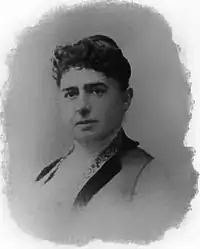
Sherman and Grace worked together as they ministered to the needs of the Wind River community, as well as raised five daughters; Effie Coolidge (adopted, b. 1898 in Wyoming); Virgie Coolidge (adopted, b. 1900 in Wyoming); Sarah Lucy Coolidge (b. March 1907 in Utah); Sophia Hope Coolidge (b. September 1912 in Minnesota); and Rose Austin Coolidge (b. 1913 in Minnesota).[7]
Grace Wetherbee Coolidge wrote extensively about her experiences working amongst the Indians. Collier's Weekly and The Outlook Magazine published her accounts. In 1917, a collection of her works was published as "Teepee Neighbors" , a series of touching brief stories of life on the Wind River Reservation in the early twentieth century.[8]
Society of American Indians

Coolidge helped found and led the Society of American Indians (1911-1923), the first national American Indian rights organization developed and run by American Indians. Of all the Society leaders, Coolidge's association with the Society was the longest.[9] The society pioneered twentieth-century Pan-Indianism, the philosophy and movement promoting unity among American Indians regardless of tribal affiliation. The Society was a forum for a new generation of American Indian leaders known as Red Progressives, prominent professionals from the fields of medicine, nursing, law, government, education, anthropology, ethnology and ministry, who shared the enthusiasm and faith of white reformers in the inevitability of progress through education and governmental action.
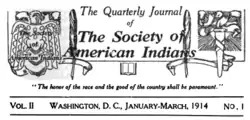
The Society met at academic institutions, maintained a Washington headquarters, conducted annual conferences and published a quarterly journal of American Indian literature by American Indian authors. Among the first proponents of an "American Indian Day", it also fought for Native American citizenship as well as opening the U.S. Court of Claims to all tribes and bands in United States. A forerunner of modern organizations such as the National Congress of American Indians, the Society anticipated by decades important Indian reforms: a major reorganization of the Indian school system in the late 1920s, the codification of Indian law in the 1930s, and the opening of the U.S. Court of Claims to Indians in the 1940s.[10][11] In September 1915, Reverend Coolidge, speaking as President of the Society, appealed for recognition of American Indians as citizens and called upon the country to observe a national "American Indian Day." In response, President Calvin Coolidge issued a proclamation on September 28, 1915, which declared the second Saturday of each May as American Indian Day. Reverend Coolidge traveled throughout United States making addresses and delivering lectures on behalf of the Society and American Indians.
Committee of One Hundred
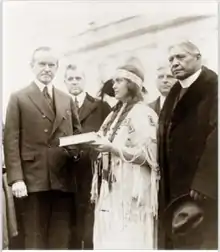

In May 1923, Coolidge and other society leaders joined with reformer John Collier founding the American Indian Defense Association, a powerful new lobby in Washington. Writers, artists, anthropologists and reformers who had been working in Indian affairs on a local basis, but who had not participated actively on the national Indian scene formed the organization.
In response, Secretary of the Interior Hubert Work invited an eminent group of Americans to form the "Advisory Council on Indian Affairs", which became known as the "Committee of One Hundred", to review and advise on Indian policy. The Committee included many distinguished men and women in public life, including Bernard M. Baruch, Nicholas Murray Butler, William Jennings Bryan, David Starr Jordan, Gen. John J. Pershing, Mark Sullivan, Roy Lyman Wilbur, William Allen White and Oswald Garrison Villard. Also included were John Collier of the American Indian Defense Association and M.K. Sniffen of the Indian Rights Association.[12] Former Society leadership included not only Rev. Coolidge, but also Arthur Caswell Parker, Dennison Wheelock, Charles Eastman, Thomas L. Sloan, Father Phillip Gordon, Henry Roe Cloud, J.N.B. Hewitt and Fayette Avery McKenzie.[13] Their recommendations prompted the Coolidge administration to commission Lewis M. Meriam and the Brookings Institution to conduct a two-year study of the overall condition of Indians in the United States.
In December 1923, Rev. Coolidge and Ruth Muskrat-Bronson presented President Calvin Coolidge a book written by G. E. E. Linquist titled "The Red Man In The United States" (1919) on behalf of the "Committee of One Hundred." In February 1928, findings and recommendations of "The Problem of Indian Administration", known as the Meriam Report, were published. The Meriam Report marked an ideological shift in American Indian policy and laid the foundation for the Indian New Deal under the Bureau of Indian Affairs leadership of John Collier during Franklin Delano Roosevelt's administration.[14]
Death and legacy
In the 1920s, Coolidge moved to Colorado, where he served as Canon at the Cathedral of St. John in the Wilderness in Denver. Coolidge died in Colorado Springs on January 24, 1932, and was buried at Evergreen Cemetery, El Paso County, Colorado. His wife Grace died five years later and was also buried there.[15][16]
Coolidge was nominated as a candidate for Wyoming Citizen of the Century, among others who distinguished themselves in their life by their character, contributions, and accomplishments as Wyoming citizens during the twentieth century.[17]
Coolidge's adoptive parents
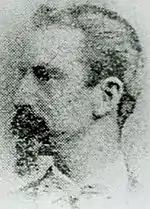
Sherman's adoptive father, Lt. Charles A. Coolidge, continued to serve in the military for 33 years. On August 9, 1877, Lieutenant Coolidge was wounded at the Battle of the Big Hole against the Nez Perce, but eventually rose to the rank of Brigadier General by 1903. He retired after 40 years service with the U.S. Infantry, died on January 1, 1926, in Detroit, Michigan (at age 81), and was interred at Arlington National Cemetery. His wife, Sophie, died on January 26, 1934, in Washington, D.C.[18]
References
- http://wc.rootsweb.ancestry.com/cgi-bin/igm.cgi?op=GET&db=eliassillhawley&id=I28490
- Henry Benjamin Whipple, Lights and Shadows of a Long Episcopate: Being Reminiscences and Recollections, (1899), p.164, Eugene Parsons, "The Indian Conference at Denver", Western Christian Advocate, February 11, 1914.
- 14 Annals of Wyoming: The Wyoming History Journal, Spring 2005. https://archive.org/stream/annalsofwyom77142005wyom/annalsofwyom77142005wyom_djvu.txt
- Henry Benjamin Whipple, p.163.
- http://www.windriverhistory.org/exhibits/jkmoore/wrschool.htm
- New York Times, October 23, 1902.
- http://wc.rootsweb.ancestry.com/cgi-bin/igm.cgi?op=GET&db=eliassillhawley&id=I28490
- Biennial Report of the State Historian of the State of Wyoming, 1919-1920, p.170. Grace Wetherbee Coolidge, Teepee Neighbors, Four Seas Press, Boston, 1917.
- Hazel W. Hertzberg, "The Search for an American Indian Identity: Modern Pan-Indian Movements", (hereinafter "Hertzberg"), Syracuse University Press, 1971, p.46.
- Hertzberg, p. 117.
- http://www.bia.gov/DocumentLibrary/HeritageMonth/
- Hertzberg, p. 202.
- Hertzberg, p. 202.
- Hertzberg, p. 204, Bernd C. Peyer, American Indian Nonfiction: An Anthology of Writings, 1760s – 1930s, (2007), P. 24.
- Rev. Coolidge Grave
- http://www.bia.gov/DocumentLibrary/HeritageMonth/
- Robert Luppi, "Sherman Coolidge (1862 - 1932): Native American Leader and Minister and Nominee as Wyoming Citizen of the Century", http://www.friendsnezpercebattlefields.org/shermancoolidgebio.htm
- See, Sherman Coolidge, "The Indian of To-Day," The Colorado Magazine, Vol.I, May 1893, p.80-94; J.T. Van Orsdale, "Rev. Sherman Coolidge, D.D.", The Colorado Magazine, Vol.I, May 1893, p.85-86; "Men and Women of America: A Biographical Dictionary of Contemporaries", (1910), pp. 393-394; Ethelbert Talbot, D.D., S.T.D., Bishop of Central Pennsylvania, "Project Canterbury: My People of the Plains", New York and London: Harper and Brothers, 1906, and Fort Washakie: From Wyoming Tales and Trails".
External links
| Wikimedia Commons has media related to Sherman Coolidge. |